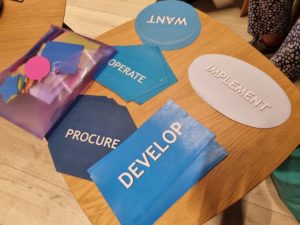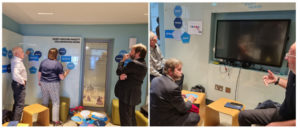On Wednesday 26th October the Collaborative Working Mentors group met to discuss the ‘traditional process’ of a build project (see image below). The aim was to examine how this process can be adapted to bring about improvements to the way a project is developed, from it’s conception to completion.

The Traditional Process
One of the first issues identified with the traditional process is the lack of consideration given to what is ‘needed’ from a project rather than what the client ‘wants’. This is an important area to get right as it will impact the functionality and usability of the end product. To do this, the project must be considered as a whole, from beginning to end, and all parties involved should be engaged at an early stage to ensure everyone understands the intended outcome.

This can be better supported by the effective communication of a client’s business case. If this part of the process fails, it can lead to a project being unsuitable for its intended use as the need and functionality of the build has been unclear. Often, nobody involves the ‘operate’ part of the traditional process until the end which is when it will become apparent if the build is not appropriate for what the client needs. However, it’s important to note that ‘operate’ should encompass all who will use the completed project, not just the client.
Improved collaboration between all parties e.g. contractors, supply chain, designers, etc. should begin before building or development takes place- design should be included within the build process. This will better support contractors and clients to understand the vision and reasoning behind different features of the build while enabling contractors to have input into the practicality of said features.

Consideration should also be given, in the design process, to how construction could be supported by the use of a standardised kit of parts, where components are designed and/or built, ready for use. This has been demonstrated on the Seismic project in which standardised joints have been designed to piece together in the same way every time but can be used across a variety of projects to achieve a different effect. Using such pre-designed parts saves time and money during the design and build process as it means the process does not have to start from scratch every time.
The Improved Process
For the next part of the meeting, members were encouraged to take the parts of the ‘traditional process’ and arrange them in a way that would be more effective.

Everyone began with their own versions of the process before narrowing the focus to one joint model which turned into more of a loop than a linear process. It was decided that this was more practical as each part should feed into the next whilst remaining a consideration throughout the whole project. A discussion then took place about the need to revisit several parts of the process at different points to realign the vision with what’s been developed so far.
For example, the ‘develop’ part of the process is where the design begins but there should be a stop point after this to evaluate the functionality of what has been created and assess how well it meets the brief. Following this, a further ‘develop’ phase can take place in which the design is completed before the ‘implement’ stage.

By the end of the meeting, a draft had been established for a ‘new process’ as opposed to the ‘traditional process’. This will be shared with members at the next meeting in order for further input and discussion to bring about a finalised version. We’d love for you to join us, register your interest here.


Comments are closed.